Launching the #CPUOverload Project: Testing Every x86 Desktop Processor since 2010
by Dr. Ian Cutress on July 20, 2020 1:30 PM ESTCPU Tests: Simulation
Simulation and Science have a lot of overlap in the benchmarking world, however for this distinction we’re separating into two segments mostly based on the utility of the resulting data. The benchmarks that fall under Science have a distinct use for the data they output – in our Simulation section, these act more like synthetics but at some level are still trying to simulate a given environment.
DigiCortex v1.35: link
DigiCortex is a pet project for the visualization of neuron and synapse activity in the brain. The software comes with a variety of benchmark modes, and we take the small benchmark which runs a 32k neuron/1.8B synapse simulation, similar to a small slug.
The results on the output are given as a fraction of whether the system can simulate in real-time, so anything above a value of one is suitable for real-time work. The benchmark offers a 'no firing synapse' mode, which in essence detects DRAM and bus speed, however we take the firing mode which adds CPU work with every firing.
I reached out to the author of the software, who has added in several features to make the software conducive to benchmarking. The software comes with a series of batch files for testing, and we run the ‘small 64-bit nogui’ version with a modified command line to allow for ‘benchmark warmup’ and then perform the actual testing.
The software originally shipped with a benchmark that recorded the first few cycles and output a result. So while fast multi-threaded processors this made the benchmark last less than a few seconds, slow dual-core processors could be running for almost an hour. There is also the issue of DigiCortex starting with a base neuron/synapse map in ‘off mode’, giving a high result in the first few cycles as none of the nodes are currently active. We found that the performance settles down into a steady state after a while (when the model is actively in use), so we asked the author to allow for a ‘warm-up’ phase and for the benchmark to be the average over a second sample time.
For our test, we give the benchmark 20000 cycles to warm up and then take the data over the next 10000 cycles seconds for the test – on a modern processor this takes 30 seconds and 150 seconds respectively. This is then repeated a minimum of 10 times, with the first three results rejected.
We also have an additional flag on the software to make the benchmark exit when complete (which is not default behavior). The final results are output into a predefined file, which can be parsed for the result. The number of interest for us is the ability to simulate this system in real-time, and results are given as a factor of this: hardware that can simulate double real-time is given the value of 2.0, for example.
The final result is a table that looks like this:
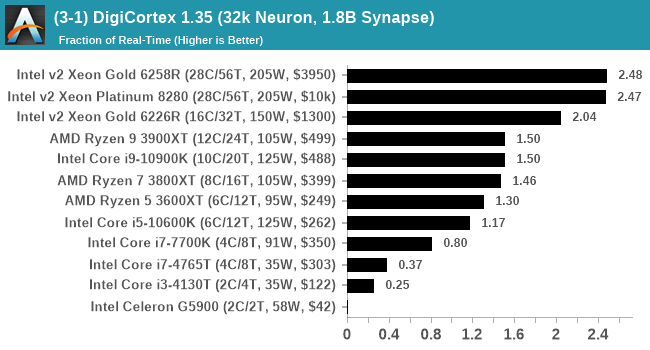
The variety of results show that DigiCortex loves cache and single thread frequency, is not too fond of victim caches, but still likes threads and DRAM bandwidth.
Dwarf Fortress 0.44.12: Link
Another long standing request for our benchmark suite has been Dwarf Fortress, a popular management/roguelike indie video game, first launched in 2006 and still being regularly updated today, aiming for a Steam launch sometime in the future.
Emulating the ASCII interfaces of old, this title is a rather complex beast, which can generate environments subject to millennia of rule, famous faces, peasants, and key historical figures and events. The further you get into the game, depending on the size of the world, the slower it becomes as it has to simulate more famous people, more world events, and the natural way that humanoid creatures take over an environment. Like some kind of virus.
For our test we’re using DFMark. DFMark is a benchmark built by vorsgren on the Bay12Forums that gives two different modes built on DFHack: world generation and embark. These tests can be configured, but range anywhere from 3 minutes to several hours. After analyzing the test, we ended up going for three different world generation sizes:
- Small, a 65x65 world with 250 years, 10 civilizations and 4 megabeasts
- Medium, a 127x127 world with 550 years, 10 civilizations and 4 megabeasts
- Large, a 257x257 world with 550 years, 40 civilizations and 10 megabeasts
I looked into the embark mode, but came to the conclusion that due to the way people played embark, to get something close to a real world data would require several hours’ worth of embark tests. This would be functionally prohibitive to the bench suite, and so I decided to focus on world generation.
DFMark outputs the time to run any given test, so this is what we use for the output. We loop the small test for as many times possible in 10 minutes, the medium test for as many times in 30 minutes, and the large test for as many times in an hour.
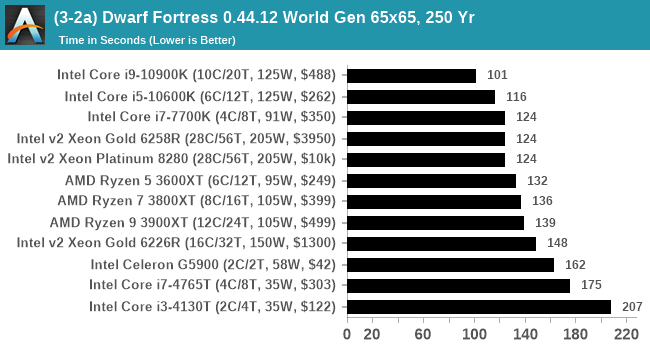
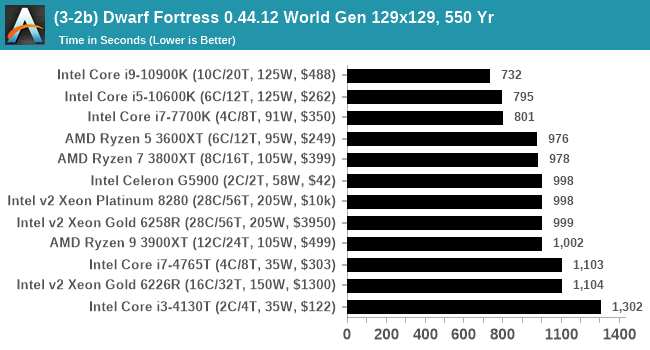
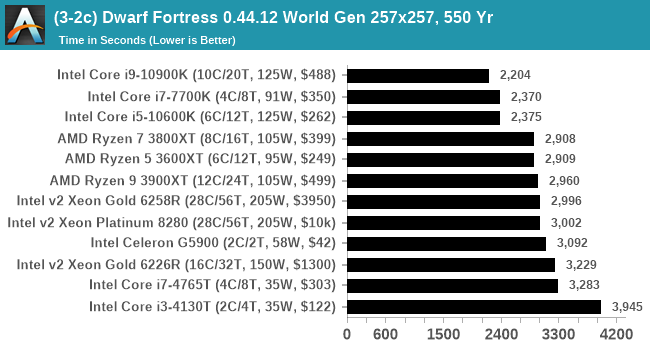
Interestingly Intel's hardware likes Dwarf Fortress. It is primarily single threaded, and so a high IPC and a high frequency is what matters here.
Dolphin v5.0 Emulation: Link
Many emulators are often bound by single thread CPU performance, and general reports tended to suggest that Haswell provided a significant boost to emulator performance. This benchmark runs a Wii program that ray traces a complex 3D scene inside the Dolphin Wii emulator. Performance on this benchmark is a good proxy of the speed of Dolphin CPU emulation, which is an intensive single core task using most aspects of a CPU. Results are given in seconds, where the Wii itself scores 1051 seconds.
The Dolphin software has the ability to output a log, and we obtained a version of the benchmark from a Dolphin developer that outputs the display into that log file. The benchmark when finished will automatically try to close the Dolphin software (which is not normal behavior) and brings a pop-up on display to confirm, which our benchmark script can detects and remove. The log file is fairly verbose, so the benchmark script iterates through line-by-line looking for a regex match in line with the final time to complete.
The final result is a table that looks like this:
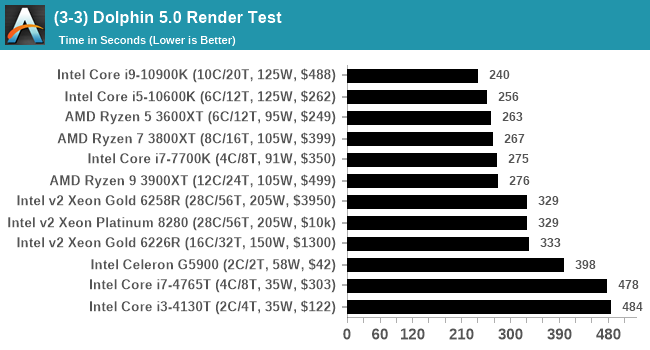
Dolphin does still have one flaw – about one in every 10 runs it will hang when the benchmark is complete and can only be removed by memory via a taskkill command or equivalent. I have not found a solution for this yet, and due to this issue Dolphin is one of the final tests in the benchmark run. If the issue occurs and I notice, I can close Dolphin and re-run the test by manually opening the benchmark in Dolphin to run again, and allow the script to pick up the final dialog box when done.




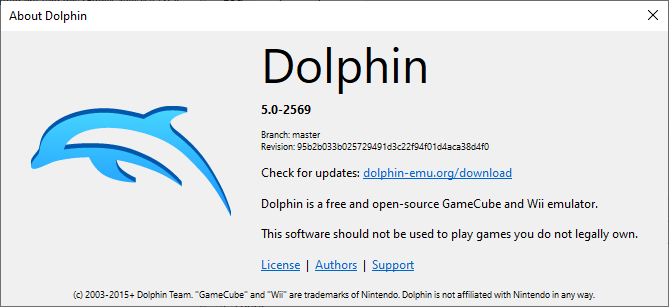








110 Comments
View All Comments
Smell This - Monday, July 20, 2020 - link
;- )
Oxford Guy - Monday, July 20, 2020 - link
"If there’s a CPU, old or new, you want to see tested, then please drop a comment below."• i7-3820. This one is especially interesting because it had roughly the same number of transistors as Piledriver on roughly the same node (Intel 32nm vs. GF 32 nm).
• 5775C
• 5675C (which outperformed and matched the 5775C in some games due to thermal throttling)
• 5775C with TDP bypassed or increased if this is possible, to avoid the aforementioned throttling
• I would really really like you to add Deserts of Kharak to your games test suite. It is the only game I know of that showed Piledriver beating Intel's chips. That unusual performance suggests that it was possible to get more performance out of Piledriver if developers targeted that CPU for optimization and/or the game's engine somehow simply suited it particularly.
• 8320E or 8370E at 4.7 GHz (non-turbo) with 2133 CAS 9-11-10 RAM, the most optimal Piledriver setup. The 9590 was not the most performant of the FX line, likely because of the turbo. A straight overclock coupled with tuned RAM (not 1600 CAS 10 nonsense) makes a difference. 4.7 GHz is a realistic speed achievable by a large AIO or small loop. If you want air cooling only then drop to 4.5 Ghz but keep the fast RAM. The point of testing this is to see what people were able to get in the real world from the AMD alternative for all the years they had to wait for Zen. Since we were stuck with Piledriver as the most performant Intel alternative for so so many years it's worth including for historical context. The "E" models don't have to be used but their lower leakage makes higher clocks less stressful on cooling than a 9000 series. 4.7 GHz was obtainable on a cheap motherboard like the Gigabyte UD3P, with strong airflow to the VRM sink.
• VIA's highest-performance model. If it won't work with Windows 10 then run the tests on it with 8.1. The thing is, though... VIA released an update fairly recently that should make it compatible with Windows 10. I saw Youtube footage of it gaming, in fact, with a discrete card. It really would be a refreshing thing to see VIA included, even though it's such a bit player.
• Lynnfield at 3 GHz.
• i7-9700K, of course.
Oxford Guy - Monday, July 20, 2020 - link
Regarding Deserts of Kharak... It may be that it took advantage of the extra cores. That would make it noteworthy also as an early example of a game that scaled to 8 threads.Oxford Guy - Monday, July 20, 2020 - link
Also, the Chinese X86 CPU, the one based on Zen 1, would be very nice to have included.Oxford Guy - Monday, July 20, 2020 - link
VIA CPUs tested with games as recently as 2019 (there was another video of the quad core but I didn't find it today with a quick search):https://www.youtube.com/watch?v=JPvKwqSMo-k
https://www.youtube.com/watch?v=Da0BkEW459E
The Zhaoxin KaiXian KX-U6880A would be nice to see included, not just the Chinese Zen 1 derivative.
Oxford Guy - Monday, July 20, 2020 - link
"due to thermal throttling"TDP throttling, to be more accurate. I suppose it could throttle due to current demand rather than temp.
axer1234 - Monday, July 20, 2020 - link
honestly i would love to know how different generation processor perform today especially higher core count. like prescott series pentium 4 athlon II phenomX6 core2 duo core2quad nehlam sandy bridge bulldozer etc with todays generation work loads and offeringin many scenario like word excel ppt photoshop it all works very well still in many offices
its just the new generation of application slowing it down for almost the same work etc
herefortheflops - Monday, July 20, 2020 - link
@Dr. Cutress.,As someone that has been dealing with similar or greater product testing challenges and configuration complexity for the better part of a decade or so, I would like to commend you for your ambitious goals and efforts so far. Additionally, I could be of high value to your effort if you are willing to discuss. I have reviewed in-depth the bench database (as well as competing websites) and I have come to the conclusion the Anandtech bench data is of very limited usefulness at present--and would require some significant changes to the data being collected/reported and the way things have been done to this point. I do understand where the industry is going, the questions the readers are going to be asking of the data, and the major comparisons that will be attempted with the data. Unfortunately, much of your effort may easily become irrelevant unless you proceed with some extreme caution to provide data with more utility. I also know methods to accomplish the desired result while reducing the size and cost of the task at hand. Reply by e-mail if you are interested in talking.
Best,
-A potential contributor to your effort.
Bensam123 - Tuesday, July 21, 2020 - link
Despite how impressive this is, one thing that hasn't been tackled is still multiplayer performance and it vastly changes recommendations for CPUs (doesn't effect GPUs as much).It goes from recommending a 6 core chip hands down to trying to make a case for 4 core chips still in this day and age. I own a 3900x and 2800 and I can tell you hands down Modern Warfare will gobble 70% of that 12 core chip, sometimes a bit more, that's equivalent to maxing out a 8 core of the same series. That vastly changes recommendations and data points. It's not just Modern Warfare. Overwatch, Black Ops 3(same engine as MW), and recently Hyper Scape will will make use of those extra cores. I have a widget to monitor CPU utilization in the background and I can check Task Manager. If I had a better video card I'm positive it would've sucked down even more of those 12 cores (my GPU is running at 100% load according to MSI AB).
This is a huge deal and while I understand, I get it, it's hard to reliably reproduce the same results in a multiplayer environment because it changes so much and generally seen as taboo from a hardware benchmarking standpoint, it is vastly different then singleplayer workloads to the point at which it requires completely different recommendations. Given how many people are making expensive hardware choices specifically because they play multiplayer games, I would even say most tech reviews in this day and age are irrelevant for CPU recommendations outside of the casual single player gamer. GPU recommendations are still very much on par, CPU is not remotely.
I talk about this frequently on my stream and why I still recommended the 1600 AF even when it was sitting at $105-125, it's a steal if you play multiplayer games, while most people that either read benchmarking websites or run benchmarks themselves will start making a case for a 4c Intel. 6 core is a must at the very least in this day and age.
Anandtech it's time to tread new ground and go into the uncharted area. Singleplayer results and multiplayer results are too different, you can't keep spinning the wheel and expect things to remain the same. You can verify this yourself just by running task manager in the background while playing one of the games I mentioned at the lowest settings regardless of being able to repeat those results exactly you'll see it's definitely a multi-core landscape for newer multiplayer games.
Not even touched on in the article.
Bensam123 - Tuesday, July 21, 2020 - link
70%, I have SMT off for clarification.